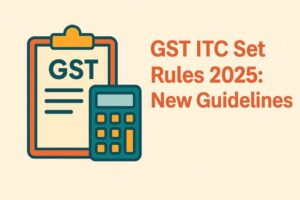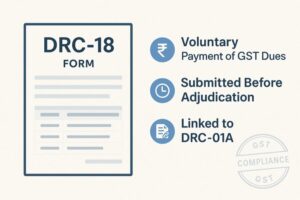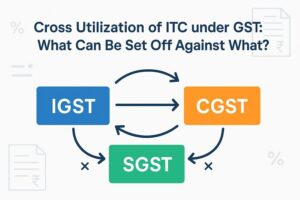Difference Between Current Tax and GST
- 31 Aug 24
- 14 mins
Difference Between Current Tax and GST
- Understanding GST and Its Mechanism
- What Is Income Tax & How Does It Operate?
- Different Types of GST Returns
- Various Types of Income Tax Returns
- Key Differences Between GST and Income Tax
- Dual Structures of Goods and Services Tax
- Advantages of Implementing GST
- Criticisms of the GST System
- How Is GST Computed?
Key Takeaways
- Income Tax and GST serve distinct roles in India's tax system, with GST focusing on consumption and Income Tax on income earned.
- GST Credit allows businesses to offset taxes paid on inputs, reducing their overall tax liability under indirect tax rates.
- The GST portion of tax payments varies by product category, reflecting different VAT rates and indirect tax structures.
- Integrated GST is applied on inter-state transactions, combining central taxes with state taxes to streamline tax collection.
- Accurate tax payments and compliance with GST rules are essential to avoid penalties and benefit from available GST credits.
Understanding GST and Its Mechanism
GST is an indirect tax that has replaced many indirect taxes like Central Excise Duty, service tax, and Value-Added Tax (VAT) in India. It was introduced to simplify the tax structure by consolidating various central and state taxes into a single tax system. GST is a destination-based tax, meaning it is collected at the point of consumption rather than the point of origin. This ensures a uniform tax structure across states and reduces the cascading effect of taxes, where tax is levied on tax.
The GST system operates through a comprehensive supply chain, where businesses collect GST on their sales (output tax) and receive credit for the GST paid on their purchases (Input Tax Credit). This mechanism helps in reducing the overall tax burden on the final consumer while ensuring that businesses do not face double taxation. GST rates are categorized into multiple slabs, such as 5%, 12%, 18%, and 28%, depending on the type of goods or services. Specific goods like luxury items may attract a higher GST rate, reflecting their non-essential nature.
Filing of GST returns is a crucial part of the GST compliance process. Businesses must regularly file their GST returns through the GST portal, reporting their sales, purchases, Input Tax Credit claimed, and the tax liability. The filing of returns can be monthly or quarterly, depending on the business's turnover. The system also requires businesses to generate e-way bills for the movement of goods across state borders, ensuring transparency and tracking in inter-state transactions.
💡 If you want to pay your GST with Credit Card, then download Pice Business Payment App. Pice is the one stop app for all paying all your business expenses.
What Is Income Tax & How Does It Operate?
Income Tax is a direct tax imposed on the income earned by individuals, Hindu Undivided Families (HUFs), and businesses. Unlike GST, which is an indirect tax on consumption, Income Tax is based on the principle of progressive taxation, where the tax rate increases as the taxpayer's income increases. This system aims to ensure a fair distribution of the tax burden, with higher earners contributing more to the revenue pool.
Income Tax is calculated on the taxable income, which is the income remaining after deducting allowable expenses, exemptions, and deductions as per the Income Tax Act. Taxpayers are required to file their income tax returns annually, disclosing their income, deductions, and the taxes paid. The government offers various deductions and exemptions under sections like 80C, 80D, and 10(14), which can reduce the taxable income, thus lowering the tax liability.
The process of filing income tax returns has become increasingly streamlined with the advent of the online portal, where taxpayers can file returns electronically. This has simplified tax compliance, allowing taxpayers to file returns from anywhere with an internet connection. The Income Tax department also issues refunds in cases where the tax paid exceeds the actual tax liability, ensuring that taxpayers are not overburdened.
Income Tax is also crucial for the Indian economy as it forms a significant part of the government's revenue, which is used for public services, infrastructure development, and social welfare programs. Unlike GST, which is collected on transactions and consumption, Income Tax is directly linked to the financial health of individuals and businesses.
Different Types of GST Returns
GST returns are essential documents that every registered taxpayer must file regularly to comply with GST regulations. The type of GST return to be filed depends on the nature of the business and its turnover. The most common types of GST returns include GSTR-1, GSTR-3B, and GSTR-9, each serving a specific purpose in the GST framework.
GSTR-1 is a monthly return that contains details of outward supplies made during the month. It is crucial for e-commerce operators and businesses involved in inter-state supplies, as it records all sales transactions. GSTR-3B is a summary return that businesses must file monthly, detailing the sales, Input Tax Credit, and net tax liability for the month. This return ensures that businesses report their GST liability and settle it in a timely manner.
GSTR-9 is the annual return that summarizes all the monthly or quarterly returns filed during the financial year. It provides a comprehensive overview of the taxpayer's activities, including the total sales, purchases, and the amount of GST paid. Filing an annual return is mandatory for all businesses with a turnover above a certain threshold, ensuring that all transactions are accounted for at the end of the year.
Additionally, there are other specialized GST returns like GSTR-4 for composition dealers, GSTR-5 for non-resident taxpayers, and GSTR-8 for e-commerce operators. Each of these returns is designed to cater to specific types of businesses and their unique compliance requirements. The GST system also includes provisions for the filing of amended returns if there are discrepancies or errors in the original returns.
Various Types of Income Tax Returns
Just like GST returns, filing the correct type of income tax return is crucial for compliance with the Income Tax Act. The type of return form to be filed depends on the taxpayer's income sources, residential status, and category. The Income Tax Department has specified different return forms, such as ITR-1, ITR-2, ITR-3, and ITR-4, each designed to accommodate various taxpayer profiles.
ITR-1, also known as Sahaj, is for individuals with income from salaries, one house property, and other sources like interest, and where the total income does not exceed ₹50 lakh. ITR-2 is for individuals and HUFs with income from multiple house properties, capital gains, or foreign assets. This form is more detailed and requires comprehensive disclosure of income and assets.
ITR-3 is for individuals and HUFs who have income from business or profession, and ITR-4, or Sugam, is for individuals, HUFs, and firms under the presumptive taxation scheme. These forms require taxpayers to provide details of their business income, expenses, and any income from other sources. Filing the correct form is crucial, as it ensures that all sources of income are accurately reported and taxed.
The filing process has been made easier with the introduction of the online portal, where taxpayers can file their returns electronically. This online system also provides pre-filled forms, helping taxpayers to quickly and accurately complete their returns. Timely filing of income tax returns is essential, as late filing can attract penalties and interest on unpaid taxes.
Key Differences Between GST and Income Tax
GST and Income Tax are fundamentally different types of taxes, each serving distinct purposes within the Indian tax system. GST is an indirect tax levied on the consumption of goods and services, while Income Tax is a direct tax imposed on the income earned by individuals and businesses. These differences influence how each tax is applied, collected, and managed.
One of the primary differences lies in the tax base. GST is applied to the supply of goods and services at every stage of the supply chain, making it a consumption tax that ultimately falls on the end consumer. In contrast, Income Tax is based on the income of the taxpayer, whether from salaries, business profits, or investments. This makes Income Tax a more personal form of taxation, reflecting the taxpayer's financial capability.
Another key difference is in the method of compliance and filing of returns. GST requires monthly or quarterly filing of returns, depending on the business's turnover, with an annual return summarizing all transactions for the year. Income Tax, on the other hand, typically requires annual filing of returns, where taxpayers report their income and claim deductions or exemptions.
The tax rates also differ significantly. GST rates vary depending on the type of goods or services, ranging from 5% to 28%, while Income Tax rates are progressive, increasing with the taxpayer's income, starting from 0% for incomes below a certain threshold to higher rates for higher income brackets. This progressive structure in Income Tax is designed to ensure equity in the tax system, while GST aims for uniformity and simplicity in indirect taxation.
Dual Structures of Goods and Services Tax
The Indian GST system is unique due to its dual structure, comprising Central Goods and Services Tax (CGST) and State Goods and Services Tax (SGST). This structure was designed to maintain the federal nature of India’s taxation system while creating a uniform tax base across the country. Under this dual system, CGST is levied by the central government, and SGST by the state governments on intra-state supplies. For inter-state transactions, the Integrated Goods and Services Tax (IGST) is applicable, which is a combination of both CGST and SGST.
This dual GST structure ensures that both the central and state governments have a share in the revenue generated from GST, which is critical for funding public services and infrastructure projects. The system is designed to prevent double taxation by allowing Input Tax Credit (ITC) for taxes paid on purchases, which can be used to offset the tax liability on sales.
The dual structure also means that businesses need to comply with both central and state GST laws, requiring them to manage dual tax registrations, filings, and payments. This can increase the tax compliance burden, but it also provides a more balanced distribution of tax revenue between the central and state governments. The dual GST system, while complex, is a significant step towards creating a unified market across India, promoting economic integration and simplifying the indirect tax landscape.
Advantages of Implementing GST

The implementation of GST has brought several advantages to the Indian economy. One of the most significant benefits is the simplification of the tax system. By replacing multiple indirect taxes like Central Sales Tax, Value-Added Tax, and excise duty with a single GST, the tax structure has become more straightforward and easier to navigate for businesses and consumers alike. This has reduced the overall tax compliance burden, making it easier for businesses to operate across state borders.
GST has also helped in reducing the cascading effect of taxes, where tax was levied on tax, leading to higher costs for goods and services. By allowing Input Tax Credit (ITC) at each stage of the supply chain, GST ensures that tax is only paid on the value added, not on the entire transaction amount. This has resulted in lower costs for consumers and improved transparency in the pricing of goods and services.
Another advantage is the positive impact of GST on the Indian economy by promoting a more integrated market. The uniform tax rates across states have eliminated the complexities of dealing with different tax rates and regulations in each state, making it easier for businesses to expand their operations nationwide. GST has also enhanced the ease of doing business in India by streamlining tax procedures and reducing the scope for tax evasion through a more transparent and accountable system.
Criticisms of the GST System
Despite its advantages, the GST system has faced criticism on several fronts. One of the main critiques is the complexity of the GST compliance process, particularly for small businesses. The requirement to file multiple returns, manage input tax credits, and ensure compliance with both central and state GST laws can be overwhelming for small and medium enterprises (SMEs). The need for regular filing of monthly returns, annual returns, and the maintenance of detailed records has increased the administrative burden on businesses.
Another criticism is the multiple GST rates, which have created confusion and increased compliance costs. The presence of different tax slabs for different goods and services, ranging from 5% to 28%, has led to disputes and uncertainty among taxpayers. This complexity has also resulted in contradictory rulings from tax authorities, leading to a lack of clarity in the interpretation and application of GST laws.
The high GST rates on certain goods, such as luxury items and certain services, have also been criticized for increasing the overall tax burden on consumers. While GST was intended to simplify the tax structure, the varying rates and the extensive list of services that fall under higher tax brackets have sometimes led to an increase in prices, affecting consumer affordability.
How Is GST Computed?
The computation of GST involves calculating the tax liability based on the value of goods or services supplied and the applicable GST rate. GST is typically computed by multiplying the taxable value of the supply by the GST rate. For example, if the value of a good is ₹1,000 and the applicable GST rate is 18%, the GST amount would be ₹180, making the total cost ₹1,180.
Businesses are required to compute GST at each stage of the supply chain, from the manufacturer to the final retailer. Input Tax Credit (ITC) plays a crucial role in this process, allowing businesses to offset the GST they have paid on purchases against the GST they need to charge on sales. This ensures that tax is only paid on the value added at each stage, rather than on the total transaction amount.
GST computation also involves the use of the GST portal, where businesses must file returns and report their GST liability. The portal provides tools for calculating GST, managing ITC, and generating e-way bills for the movement of goods. Businesses must also consider the impact of inter-state transactions, where IGST is applicable, and ensure that they are complying with both central and state GST regulations. Proper computation and timely payment of GST are essential to avoid penalties and ensure smooth business operations.
 By
By 
















